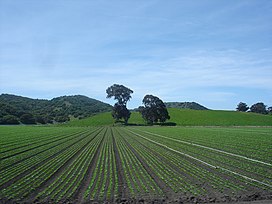| Salinas Valley | |
|---|---|
| Valle de Salinas (Spanish) | |
 Salinas Valley, on River Road near Salinas and Marina. | |
| Length | 90 miles (145 km) northwest to southeast |
| Geography | |
| Location | California, United States |
| Population centers | Castroville, Salinas, King City, San Ardo |
| Traversed by | U.S. Route 101 |
| Rivers | Salinas River |
The Salinas Valley (Spanish: Valle de Salinas)[1][2] is one of the major valleys and most productive agricultural regions in California.[3] It is located west of the San Joaquin Valley and south of San Francisco Bay and the Santa Clara Valley.
The Salinas River, which geologically formed the fluvial valley and generated its human history, flows to the northwest or 'up' along the principal axis and the length of the valley.
The valley was named during the late 18th-century Spanish colonial Alta California period, and in Spanish Salina is the term for a salt marsh, salt lake, or salt pan. The seasonal Salinas River had brackish tule ponds in broad depressed areas, and more salinity during summer and when drought lowered flows.
The valley runs in a southeast to northwest alignment. It begins south of San Ardo, framed by the central inner California Coast Ranges, continues northwestward continuously defined on the west by the Santa Lucia Range, on the east by the Gabilan Range, to its end and the river's mouth at the Monterey Bay.
It is also known for being the setting of the novels East of Eden and Of Mice and Men, both by John Steinbeck.
- ^ Kion546 - Dueños de negocios se alegran el poder volver a la feria del Valle de Salinas
- ^ Clinica de Salud del Valle de Salinas
- ^ McKibben, Carol Lynn (2022). Salinas : a history of race and resilience in an agricultural city. Stanford, California. ISBN 978-1-5036-2945-5. OCLC 1236850398.
{{cite book}}: CS1 maint: location missing publisher (link)